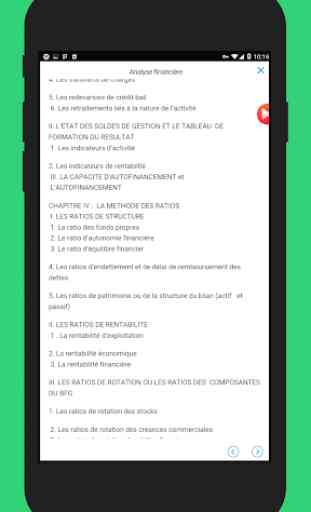Cours Analyse financière
financial analysis courses and corrected exercises pdf
COURSE MAP
GENERAL INTRODUCTION
CHAPTER I: THE FINANCIAL ANALYSIS APPROACH
I- OBJECTIVES OF THE FINANCIAL ANALYSIS II-THE SCHEME DIRECTEUR OF THE ANALYSIS.
CHAPTER II: ANALYSIS OF FINANCIAL EQUILIBRIUM
I - DESCRIPTIVE STUDY OF ACCOUNTING BALANCE SHEET. 1. Schematic presentation. 2. Explanations for certain positions.
II. THE FUNCTIONAL APPROACH.
1-. Functional assessment 2- Functional balance indicators
III. FINANCIAL APPROACH
1. The liquidity balance sheet 2. The concept of financial equilibrium
CHAPTER III: ANALYSIS OF THE ACTIVITY AND APPRAISAL OF THE PERFORMANCE OF THE COMPANY
I. RETIREMENT OF CPC POSITIONS 1. Subcontracting 2. Remuneration of non-company staff. 3. Operating subsidies.
4. Transfers of charges
5. Leasing fees 6. Restatements related to the nature of the activity
II. STATEMENT OF MANAGEMENT BALANCES AND RESULTS TRAINING CHART 1. Activity indicators
2. Profitability indicators III. AUTOFINANCING CAPACITY and AUTOFINANCING
CHAPTER IV: THE RATIOS METHOD I. THE STRUCTURE RATIOS 1. The capital ratio 2. The financial autonomy ratio 3. The financial equilibrium ratio
4. Debt and debt repayment ratios
5. Asset ratios or balance sheet structure (assets and liabilities)
II. PROFITABILITY RATIOS 1. Operating profitability
2. Economic profitability 3. Financial profitability
III. ROTATIONAL RATIOS OR RATIOS OF BFG COMPONENTS
1. Turnover ratios of inventories
2. Turnover ratios 3. Turnover ratios of trade payables
IV. LIQUIDITY OR CASH RATIOS
114 V. Case of synthesis
COURSE MAP
GENERAL INTRODUCTION
CHAPTER I: THE FINANCIAL ANALYSIS APPROACH
I- OBJECTIVES OF THE FINANCIAL ANALYSIS II-THE SCHEME DIRECTEUR OF THE ANALYSIS.
CHAPTER II: ANALYSIS OF FINANCIAL EQUILIBRIUM
I - DESCRIPTIVE STUDY OF ACCOUNTING BALANCE SHEET. 1. Schematic presentation. 2. Explanations for certain positions.
II. THE FUNCTIONAL APPROACH.
1-. Functional assessment 2- Functional balance indicators
III. FINANCIAL APPROACH
1. The liquidity balance sheet 2. The concept of financial equilibrium
CHAPTER III: ANALYSIS OF THE ACTIVITY AND APPRAISAL OF THE PERFORMANCE OF THE COMPANY
I. RETIREMENT OF CPC POSITIONS 1. Subcontracting 2. Remuneration of non-company staff. 3. Operating subsidies.
4. Transfers of charges
5. Leasing fees 6. Restatements related to the nature of the activity
II. STATEMENT OF MANAGEMENT BALANCES AND RESULTS TRAINING CHART 1. Activity indicators
2. Profitability indicators III. AUTOFINANCING CAPACITY and AUTOFINANCING
CHAPTER IV: THE RATIOS METHOD I. THE STRUCTURE RATIOS 1. The capital ratio 2. The financial autonomy ratio 3. The financial equilibrium ratio
4. Debt and debt repayment ratios
5. Asset ratios or balance sheet structure (assets and liabilities)
II. PROFITABILITY RATIOS 1. Operating profitability
2. Economic profitability 3. Financial profitability
III. ROTATIONAL RATIOS OR RATIOS OF BFG COMPONENTS
1. Turnover ratios of inventories
2. Turnover ratios 3. Turnover ratios of trade payables
IV. LIQUIDITY OR CASH RATIOS
114 V. Case of synthesis
Category : Books & Reference

Related searches




